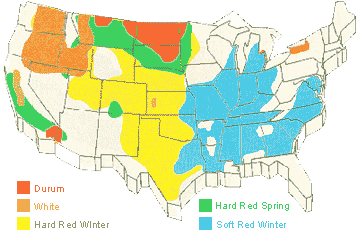Consumption
In the United States, about 148 pounds of wheat flour were consumed per capita in 1998. The worldwide average per capita wheat consumption was about 100 pounds in 1996. Human consumption accounts for about 70% of worldwide and national wheat use, with the rest going towards animal feed. These facts are excerpted from a longer treatise on world wheat facts and trends published by the Consultative Group on International Agricultural Research.
Production
Unfinished wheat is milled into flour before being sold. It is stored in a grain elevator before being inspected and classified, as detailed in the food safety section. Then, it is passed through multiple levels of impurity removal before being tempered, blended, and sifted. The WheatMania site shows a diagram of this involved process.
Distribution
The top ten wheat-producing countries are China, India, the United States, France, the Russian Federation, Canada, Australia, Germany, Turkey, and Pakistan. Together, they produced 419,583,410 metric tons of wheat in 1999 out of a total of 541,947,927 metric tons produced worldwide. China produces 1/5 of the world's wheat, and combined with India, the US, and France, produces more than the other 27 wheat-producing nations together.
Forty of the 50 US states produce some amount of wheat, with the major output (>100 million bushels) coming from Kansas, North Dakota, Montana, Oklahoma, Washington, Texas, South Dakota, Colorado, and Idaho. Total US production exceeded 2.3 billion bushels in 1999. The following table offers more detailed information on the distribution of wheat-production throughout the US.
| State |
Area Harvested
(1000 acres) |
Yield
(bushels/acre) |
Production
(1000 bushels) |
| Arizona |
85 |
97.9 |
8325 |
| Wyoming |
193 |
33.1 |
6393 |
| Maryland |
200 |
60 |
12000 |
| Nebraska |
200 |
48 |
86400 |
| Virginia |
240 |
57 |
13680 |
| New Mexico |
270 |
38 |
10260 |
| Kentucky |
410 |
60 |
24600 |
| California |
455 |
83 |
37785 |
| North Carolina |
580 |
49 |
28420 |
| Oregon |
783 |
44.3 |
34659 |
| Arkansas |
920 |
56 |
51520 |
| Ohio |
1030 |
70 |
72100 |
| Idaho |
1350 |
77.4 |
104520 |
| Minnesota |
1990 |
39.8 |
79210 |
| Washington |
2290 |
54.2 |
124140 |
| Colorado |
2450 |
43.8 |
107200 |
| South Dakota |
3024 |
39.9 |
120582 |
| Texas |
3400 |
36 |
122400 |
| Oklahoma |
4300 |
35 |
150500 |
Montana |
5320 |
29 |
154310 |
| North Dakota |
8657 |
28 |
242109 |
| Kansas |
9200 |
47 |
432400 |
| |
Total
47347 |
Average
51.2 |
Total
2023513 |
Land Use
About 47 million acres of land is occupied by wheat cultivation in the US. The figure below, adapted from the Montana Wheat and Barley Committee website, depicts the regions in which each different type of wheat is grown. Some areas are suitable for multiple types of wheat growing.

Agrochemicals
Fertilizers are the most commonly used agrochemical for wheat, with up to 95% nitrogen usage on spring wheat in some states. Nitrogen, phosphates, and potash are the three most widely-applied fertilizers. Herbicides such as 2, 4-D and MCPA were used on about half the acreage planted. Only 4 percent of total acreage employed insecticides, due to other pest management strategies such as timed planting and scouting. Chlorpyrifos composed about 92% of the 548,000 pounds of pesticides applied in the 16 states surveyed. More detailed information can be accessed by downloading this USDA/Cornell .pdf file. See the EPA web site for information about these chemicals and their estimated health risks for humans.
(To view the above data sheet, which is formatted as a .pdf, you must have the free Adobe Acrobat Reader)
Food Safety
The USDA regulates maximum percentages of damaged and impure grains for the five grades of wheat. These percentages can be found on this page of the Small Grains website. In addition, engineering laboratories such as the Grain Quality and Structure Unit at Kansas State University provide sophisticated instruments for measuring various aspects of food grain safety.